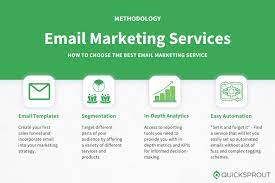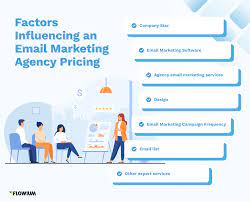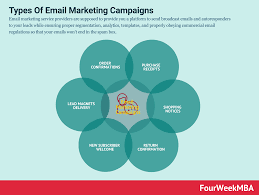Title: The Top Email Marketing Websites for Effective Campaigns
Introduction:
Email marketing has become an indispensable tool for businesses to connect with their target audience and drive conversions. To make the most of this powerful strategy, it’s crucial to choose the right email marketing platform. In this article, we will explore some of the best email marketing websites that offer a range of features to help you create, automate, and optimize your campaigns.
Mailchimp:
Mailchimp is a popular choice for both small businesses and large enterprises. It offers a user-friendly interface with drag-and-drop functionality, making it easy to design visually appealing emails without any coding knowledge. With advanced automation features, A/B testing capabilities, and detailed analytics, Mailchimp provides comprehensive tools to optimize your campaigns.
Constant Contact:
Constant Contact is known for its simplicity and ease of use. It offers a wide range of customizable templates, making it effortless to create professional-looking emails. This platform also provides robust list management features, including segmentation options based on customer behavior or demographics. Constant Contact’s real-time tracking allows you to monitor the success of your campaigns and make data-driven decisions.
SendinBlue:
SendinBlue is a versatile email marketing platform that caters to businesses of all sizes. With its intuitive interface and powerful automation tools, you can easily set up personalized workflows based on user actions or triggers. Additionally, SendinBlue offers SMS marketing integration alongside email campaigns, providing a multi-channel approach to engage with your audience effectively.
GetResponse:
GetResponse is an all-in-one marketing platform that goes beyond just email marketing. Alongside its robust email features like autoresponders and customizable templates, GetResponse offers landing page creation tools and webinar hosting capabilities. With its comprehensive suite of tools and integrations, GetResponse is ideal for businesses looking for a complete digital marketing solution.
ConvertKit:
ConvertKit is designed specifically for content creators, bloggers, and online entrepreneurs. It offers powerful automation features that allow you to segment your audience based on their interests and actions. ConvertKit’s simplicity and focus on delivering valuable content make it a popular choice for those looking to nurture their audience and build long-term relationships.
Conclusion:
Choosing the right email marketing website is crucial for the success of your campaigns. Each platform mentioned in this article offers unique features tailored to different business needs. Whether you’re a small business owner or a large enterprise, consider your requirements, budget, and desired level of automation before making a decision. By leveraging the power of these top email marketing websites, you can effectively engage with your audience and drive conversions for your business.
7 Essential Tips for Choosing the Best Email Marketing Websites
- Use a reliable and reputable email marketing platform. It’s important to choose a provider that has good customer service, is secure and can handle your volume of emails.
- Make sure you are GDPR compliant when collecting data for email campaigns. Make sure you have permission from the recipient before sending them any emails.
- Utilise segmentation techniques to target specific types of customers with tailored content that will be more likely to engage with the message.
- Create an effective subject line that will grab the attention of your recipients and make them want to open your emails.
- Test different versions of your messages by using A/B testing or split testing in order to find out which one works best for each type of audience segmentation you are targeting with your campaign .
- Monitor analytics closely and use this information to adjust future campaigns accordingly in order to maximise results from each send-out .
- Keep track of unsubscribes, bounces, open rates etc., as these metrics will help inform how successful each campaign has been and what needs improving in the next one .
Use a reliable and reputable email marketing platform. It’s important to choose a provider that has good customer service, is secure and can handle your volume of emails.
Title: The Importance of Choosing a Reliable and Reputable Email Marketing Platform
In the fast-paced world of digital marketing, email campaigns have proven to be a highly effective tool for businesses to connect with their audience and drive engagement. However, to ensure the success of your email marketing efforts, it is crucial to choose a reliable and reputable email marketing platform. Here’s why:
Good Customer Service:
When you encounter any issues or have questions about your email campaigns, having access to reliable customer service is invaluable. A reputable email marketing platform will provide prompt and knowledgeable support, helping you troubleshoot problems and optimize your campaigns effectively. Look for platforms that offer various support channels such as live chat, phone support, or dedicated account managers.
Security:
Data security is paramount when it comes to handling sensitive customer information. A trustworthy email marketing platform will prioritize data protection measures, including encryption protocols and secure servers. By choosing a reputable provider, you can have peace of mind knowing that your subscribers’ personal information is safeguarded against potential cyber threats.
Scalability:
As your business grows, so will your email marketing needs. It’s essential to select an email marketing platform that can handle the volume of emails you plan to send without compromising deliverability or performance. Reputable platforms often offer scalable solutions that can accommodate increasing subscriber lists and growing campaign requirements.
Deliverability:
The success of your email campaigns relies heavily on deliverability – ensuring that your emails reach recipients’ inboxes rather than being flagged as spam or ending up in the promotions folder. Reputable providers have established relationships with internet service providers (ISPs) and adhere to industry best practices, increasing the chances of high deliverability rates for your emails.
Advanced Features:
A reliable email marketing platform will offer a wide range of advanced features designed to enhance the effectiveness of your campaigns. These may include automation tools, A/B testing capabilities, segmentation options, and detailed analytics. By leveraging these features, you can create highly targeted and personalized email campaigns that resonate with your audience and drive better results.
In conclusion, choosing a reliable and reputable email marketing platform is crucial for the success of your campaigns. Look for providers that offer excellent customer service, prioritize data security, can handle your email volume, ensure high deliverability rates, and provide advanced features. By investing in the right platform, you can optimize your email marketing efforts, engage with your audience effectively, and achieve your business goals.
Make sure you are GDPR compliant when collecting data for email campaigns. Make sure you have permission from the recipient before sending them any emails.
Title: Ensuring GDPR Compliance for Effective Email Marketing Campaigns
In the digital age, email marketing has proven to be a powerful tool for businesses to connect with their target audience. However, it’s essential to prioritize data protection and comply with regulations such as the General Data Protection Regulation (GDPR). One crucial aspect of GDPR compliance is obtaining proper consent from recipients before sending them any emails. Let’s explore why this is important and how it can benefit your email marketing efforts.
The GDPR, implemented in 2018, aims to protect the privacy and personal data of individuals within the European Union (EU). It sets strict guidelines for businesses that collect, process, and store personal data. When it comes to email marketing campaigns, ensuring compliance with GDPR is not only a legal obligation but also a way to build trust with your audience.
Obtaining explicit permission from recipients before sending them emails is a fundamental requirement of GDPR. This means you must have clear consent from individuals stating that they are willing to receive communications from you. It’s crucial to provide transparent information about how their data will be used and give them the option to unsubscribe or manage their preferences easily.
By adhering to these guidelines, you can enjoy several benefits:
- Enhanced Reputation: Demonstrating your commitment to data protection and respecting individuals’ privacy rights enhances your reputation as a trustworthy business. This fosters trust among your audience and increases their willingness to engage with your emails.
- Improved Engagement: When recipients have given explicit consent, they are more likely to engage with your emails because they have actively chosen to receive them. This can lead to higher open rates, click-through rates, and ultimately better conversion rates.
- Higher Deliverability: Email service providers prioritize delivering emails from senders who follow best practices and comply with regulations. By obtaining proper consent, you reduce the risk of being marked as spam or having your emails blocked by ISPs (Internet Service Providers).
- Legal Compliance: Ensuring GDPR compliance protects your business from potential legal consequences, such as fines or penalties. By following the regulations, you demonstrate your commitment to upholding privacy rights and data protection laws.
To ensure GDPR compliance when collecting data for email campaigns, consider the following practices:
– Implement clear and concise consent forms on your website or landing pages.
– Provide detailed information about how you will use recipient data and offer options for managing preferences.
– Regularly review and update your privacy policy to reflect any changes in data processing practices.
– Keep records of consent to demonstrate compliance if required.
In conclusion, GDPR compliance is crucial when collecting data for email marketing campaigns. Obtaining explicit permission from recipients not only ensures legal compliance but also builds trust with your audience, leading to improved engagement and better results. By prioritizing data protection and respecting individuals’ privacy rights, you can establish a strong foundation for successful and ethical email marketing practices.
Utilise segmentation techniques to target specific types of customers with tailored content that will be more likely to engage with the message.
Utilizing Segmentation Techniques for Effective Email Marketing
One of the most powerful strategies in email marketing is segmentation. By dividing your audience into specific groups based on their interests, demographics, or behaviors, you can deliver tailored content that resonates with each segment. This targeted approach increases the chances of engaging your customers and achieving higher conversion rates.
Segmentation allows you to understand your customers better and send them messages that are relevant to their needs and preferences. Here’s how you can make the most of this technique:
- Analyze Your Customer Data: Start by gathering data about your customers, such as their purchase history, browsing behavior, or demographic information. This data will help you identify patterns and characteristics that can be used to create meaningful segments.
- Define Segments: Once you have collected sufficient data, categorize your audience into distinct segments based on common attributes or behaviors. For example, you may create segments for new subscribers, loyal customers, or those who have shown interest in a particular product or service.
- Tailor Content: Develop personalized content for each segment that addresses their specific needs or interests. By delivering messages that speak directly to their pain points or desires, you increase the likelihood of capturing their attention and driving engagement.
- Automation and Dynamic Content: Utilize email marketing platforms that offer automation features to streamline the process of sending targeted emails. With automation tools, you can set up triggers based on customer actions or time intervals to ensure timely delivery of relevant content.
- Test and Refine: Regularly monitor the performance of your segmented campaigns by analyzing open rates, click-through rates, and conversions. Use this data to refine your segments further and optimize your content for better results.
The benefits of segmentation are numerous – increased open rates, higher click-through rates, improved customer satisfaction – all leading to a more effective email marketing strategy overall.
Remember that effective segmentation requires ongoing analysis and adjustment as customer preferences evolve. By investing time and effort into segmenting your audience and tailoring your content accordingly, you will create a more personalized and engaging experience for your customers, ultimately leading to better results for your business.
Create an effective subject line that will grab the attention of your recipients and make them want to open your emails.
The Importance of Crafting Attention-Grabbing Subject Lines in Email Marketing
When it comes to email marketing, the subject line is your first chance to make a lasting impression on your recipients. A well-crafted subject line can be the difference between your email being opened and engaged with or ignored and sent straight to the trash bin. In this article, we will explore the importance of creating effective subject lines that captivate your audience and entice them to open your emails.
First impressions matter, and in the crowded inbox of today’s digital world, you need to stand out. A compelling subject line is like a virtual handshake that grabs attention and piques curiosity. It should be concise, clear, and relevant to the content inside the email. Avoid using generic or spammy phrases that might trigger spam filters or give off an unprofessional impression.
To create an attention-grabbing subject line, consider these tips:
- Personalization: Addressing recipients by their name can make your email feel more personalized and increase the chances of it being opened. Use data from your subscriber list to dynamically insert their name into the subject line.
- Urgency: Incorporate words that create a sense of urgency or exclusivity. Phrases like “Limited Time Offer,” “Last Chance,” or “Exclusive Invitation” can motivate recipients to take action quickly.
- Curiosity: Spark curiosity by offering a glimpse into what’s inside without giving away too much information. Intriguing subject lines like “Unlock Secrets to…” or “Discover Something Amazing” can entice recipients to open your email out of sheer curiosity.
- Benefit-driven: Highlighting a clear benefit or value proposition in your subject line can compel recipients to open the email in search of solutions or valuable content. For example, “Increase Your Sales by 50%” or “Get Exclusive Tips for Boosting Productivity.”
- Personal touch: Experiment with using emojis sparingly to add a touch of personality and visual appeal to your subject lines. However, ensure that emojis are relevant and align with your brand image.
Remember, subject lines should accurately reflect the content inside your email. Misleading or clickbait subject lines may lead to recipients unsubscribing or losing trust in your brand. A consistent and trustworthy approach will help build a loyal audience.
In conclusion, crafting attention-grabbing subject lines is crucial for the success of your email marketing campaigns. By incorporating personalization, urgency, curiosity, benefits, and a personal touch, you can increase open rates and engage with your audience effectively. Experiment with different strategies, analyze the results, and refine your approach over time. With a compelling subject line, you can make a strong first impression and encourage recipients to eagerly open your emails for valuable content and offers.
Test different versions of your messages by using A/B testing or split testing in order to find out which one works best for each type of audience segmentation you are targeting with your campaign .
Title: Enhance Your Email Marketing Success with A/B Testing
Introduction:
When it comes to email marketing, one size does not fit all. To ensure your messages resonate with different segments of your audience, it’s essential to test and optimize your email campaigns. A/B testing or split testing is a powerful technique that allows you to experiment with different versions of your messages and determine which ones yield the best results for each specific audience segment. In this article, we’ll explore how A/B testing can help you enhance the effectiveness of your email marketing campaigns.
Understanding A/B Testing:
A/B testing involves creating two or more variations of an email and sending them to different segments of your audience. By comparing the performance metrics (such as open rates, click-through rates, and conversions) of each variation, you can identify which version resonates better with a particular segment.
Segmentation is Key:
To make the most out of A/B testing, it’s crucial to segment your audience based on relevant criteria such as demographics, interests, or past behavior. By targeting specific segments with tailored messages, you can understand their preferences and optimize future campaigns accordingly.
Testing Variables:
When conducting A/B tests, focus on testing one variable at a time. This could include subject lines, email copy, call-to-action buttons, images, or even the layout of your emails. By isolating variables in this manner, you can determine precisely what element influences engagement and conversion rates.
Measuring Results:
Accurate measurement is vital for successful A/B testing. Pay close attention to key metrics such as open rates (indicating the effectiveness of subject lines), click-through rates (reflecting engagement with content), and conversion rates (measuring desired actions taken by recipients). Analyzing these metrics will help you identify patterns and make data-driven decisions.
Iterate and Improve:
A/B testing should be an ongoing process rather than a one-time experiment. Continually test different variations and refine your email marketing strategy based on the insights gained. By consistently optimizing your campaigns, you can maximize engagement and drive better results.
Conclusion:
A/B testing or split testing is a valuable technique that empowers you to optimize your email marketing campaigns for different audience segments. By experimenting with various versions of your messages, you can uncover what resonates best with each segment, leading to increased engagement, conversions, and ultimately, business success. Embrace A/B testing as a strategic tool in your email marketing arsenal and unlock the potential to deliver highly effective campaigns that drive meaningful results.
Monitor analytics closely and use this information to adjust future campaigns accordingly in order to maximise results from each send-out .
Maximizing Email Marketing Results: The Power of Analytics
Email marketing is a powerful tool for businesses to connect with their audience and drive conversions. However, it’s not enough to just send out emails and hope for the best. To truly maximize your results, it’s crucial to monitor analytics closely and use that information to adjust future campaigns accordingly.
Analytics provide valuable insights into the performance of your email campaigns. By tracking metrics such as open rates, click-through rates, conversion rates, and subscriber engagement, you gain a deeper understanding of what resonates with your audience and what doesn’t.
One of the key benefits of monitoring analytics is the ability to identify trends and patterns. By analyzing the data over time, you can determine which types of emails perform best and which ones may need improvement. For example, if you notice that certain subject lines consistently yield higher open rates, you can replicate that success in future campaigns.
In addition to identifying successful strategies, analytics also reveal areas for improvement. If you find that certain emails have low click-through rates or high unsubscribe rates, it’s a clear indication that something needs adjustment. Perhaps the content isn’t engaging enough or the call-to-action needs to be more compelling. By making data-driven decisions based on analytics, you can fine-tune your campaigns for better results.
Another benefit of monitoring analytics is the opportunity for A/B testing. By testing different elements such as subject lines, email layouts, or call-to-action buttons on a portion of your audience, you can gather data on what works best before rolling out the winning version to your entire subscriber list. This iterative approach allows you to constantly improve your email marketing strategy over time.
To make the most of analytics in email marketing:
- Set specific goals: Determine what metrics are most important for measuring success based on your objectives (e.g., increased sales, website traffic).
- Use reliable email marketing platforms: Choose an email marketing website that provides comprehensive analytics tools, allowing you to track and analyze key metrics easily.
- Regularly review and analyze data: Make it a habit to monitor your email campaign analytics regularly. Look for trends, patterns, and areas for improvement.
- Implement changes based on insights: Use the information gathered from analytics to adjust future campaigns. Experiment with different elements and strategies to optimize your results.
Remember, email marketing is an iterative process. By closely monitoring analytics and using that information to refine your campaigns, you can continuously improve your email marketing strategy, increase engagement with your audience, and ultimately achieve better results.
Keep track of unsubscribes, bounces, open rates etc., as these metrics will help inform how successful each campaign has been and what needs improving in the next one .
Title: The Importance of Tracking Metrics in Email Marketing Campaigns
Introduction:
Email marketing has proven to be a highly effective tool for businesses to connect with their audience and drive conversions. To ensure the success of your campaigns, it is important to keep track of key metrics such as unsubscribes, bounces, and open rates. These metrics provide valuable insights into the performance of your campaigns and help identify areas for improvement in future ones. In this article, we will explore why tracking these metrics is crucial for email marketing success.
Unsubscribes:
Unsubscribes are an inevitable part of email marketing. While it may be disheartening to see subscribers leave your list, tracking unsubscribes is essential for understanding the effectiveness of your campaigns. A high unsubscribe rate could indicate that your content or frequency isn’t resonating with your audience. By analyzing the reasons behind unsubscribes, you can make necessary adjustments to improve future campaigns and better cater to your subscribers’ preferences.
Bounces:
Bounces occur when an email fails to reach its intended recipient. Tracking bounce rates helps you maintain a clean and healthy email list. High bounce rates may be indicative of outdated or incorrect email addresses or issues with deliverability. By regularly monitoring bounce rates, you can identify problematic addresses and take appropriate action like updating contact information or removing invalid addresses from your list.
Open Rates:
Open rates measure the percentage of recipients who open your emails. This metric provides insights into how engaging and compelling your subject lines and preview text are. Low open rates may indicate that your emails are not capturing the attention of your subscribers or ending up in spam folders. By experimenting with different subject lines, personalization techniques, or segmenting your audience based on their interests, you can improve open rates and increase engagement.
Click-through Rates:
Click-through rates measure the percentage of recipients who click on links within your emails. This metric indicates how effective your call-to-action (CTA) is and whether your content is driving desired actions. Low click-through rates may suggest that your CTAs are not clear or enticing enough. By analyzing click-through rates, you can optimize your CTAs, improve the relevance of your content, and drive more traffic to your website or landing pages.
Conclusion:
Tracking metrics such as unsubscribes, bounces, open rates, and click-through rates is crucial for evaluating the success of your email marketing campaigns. These metrics provide valuable insights into how well your emails are resonating with your audience and help identify areas for improvement. By consistently monitoring these metrics and making data-driven decisions, you can refine your strategies, create more engaging content, and ultimately achieve better results in future campaigns. Remember, continuous improvement based on these metrics will contribute to the long-term success of your email marketing efforts.




